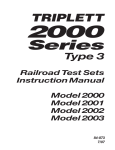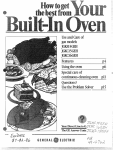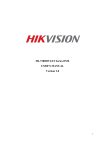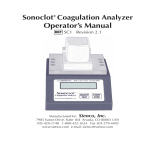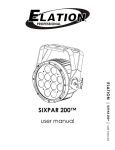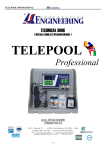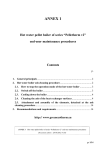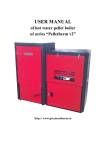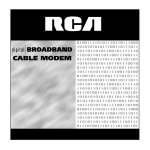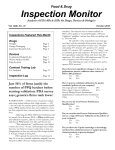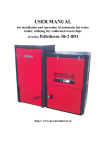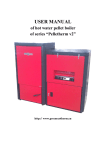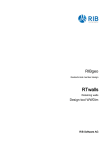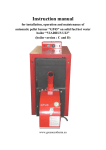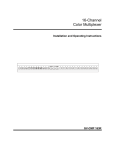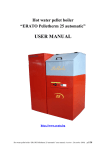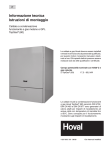Download Installation and operation
Transcript
MANUAL FOR OPERATION OF COMBINED WOOD GASIFICATION HOT WATER BOILER, UTILIZING WOOD LOGS, WOOD PELLETS AND DRY CALIBRATED WOOD CHIPS, FROM SERIES 3Fera 25/35/45 http:// www.greenecotherm.eu Manufacturer ZMM Haskovo PLC. Address 67 Saedinenie, 6300 Haskovo, Bulgaria Telephone +359 800 15 145 Fax +359 38 603070 e-mail [email protected] home page www.greenecotherm.eu The manufacturing company thanks you for the contribution of your choice. The manufacturing company provides this manual in help to the team that will install, adjust and service this system, as well as to the customer that will operate it. The manufacturing company requires that the technicians performing the above presented procedures has passed training course for the activities performed with the product. User manual for operation and installation of combined wood gasification hot water boiler, operating with wood logs, wood pellets and dry calibrated wood chips, from series “3Fera 25/35/45” (Edition: 21.12.2012 г. 05:44:00 ч.) 3Fera 25/35/45 2 CONTENT page 1. 2. 3. 4. 5. 6. 6.1. 6.2. 6.3. 6.3.1. 6.3.2. 6.3.3. 6.3.4. 6.4. 6.5. 6.5.1. 6.5.2. 6.6. 6.6.1. 6.6.2. 6.7. 6.7.1. 6.8. 6.9. 6.10. 6.11. 6.12. 7. 8. 9. INFORMATION RELATED TO THE USERS SAFETY. ............................................................ 4 DESRIPTION AND ADVANTAGES OF COMBINED WOOD GASIFICATION HOT WATER BOILER FROM SERIES “3 FERA”. ........................................................................................... 5 TECHNICAL DATA FOR COMBINED WOOD GASIFICATION HOT WATER BOILER FROM SERIES “3 FERA”. ..................................................................................................................... 7 CONSTRUCTION DESCRIPTION OF COMBINED WOOD GASIFICATION HOT WATER BOILER FROM SERIES “3 FERA”. ......................................................................................... 10 MOUNTING AND INSTALLATION OF THE BOILER.............................................................. 17 INITIALIZATION OF THE APPLIANCE IN OPERATION. ....................................................... 23 GENERAL REQUIREMENTS ABOUT THE USED FUEL....................................................... 23 GENERAL REQUIEMENTS DURING OPERATION OF THE HEATING INSTALLATION ….23 INITILIZATION OF HOT WATER BOILER FROM SERIES “3FERA” IN OPERATION. ......... 24 ADJUSTMENT OF THE FIRING AIR FLOW RATE THERMO-REGULATION VALVE. ......... 25 INTERFACE CONTROL PANEL OF HOT WATER BOILER FROM SERIES “3FERA”. ........ 26 BOILER POWER SUPPLY. ..................................................................................................... 27 BOILER SWTICH ON. ............................................................................................................. 28 CHANGING THE BOILER OPERATION PARAMETERS. ...................................................... 30 PARAMETERS FOR ADJUSTMENT OF THE BOILER OPERATION. .................................. 32 OPERATION OF THE BOILER WITH FUEL - MANUAL REFUELING WITH FIREWOOD.... 32 OPERATION OF THE BOILER IN COMBINED MODE - AUTOMATED FEEDING WITH WOOD PELLETS OR DRY CALIBRATED WOOD CHIPS. .................................................... 34 ADJUSTMENT OF THE BOILER HEATING OUTPUT. .......................................................... 36 OPERATION MODE DURING FIREWOOD UTILIZATION..................................................... 36 BOILER OPERATION IN COMBINED MODE......................................................................... 37 STOPPING THE BOILER OPERATION.................................................................................. 38 BOILER EMERGENCY SHUT DOWN. ................................................................................... 39 BOILER SHUT DOWN............................................................................................................. 39 BOILER CLEANING................................................................................................................. 39 USER INTRODUCTION WITH THE SERVICING AND ADJUSTMENT PROCEDURES OF THE BOILER............................................................................................................................ 41 SAFETY AND UNPREDICTED RISKS.................................................................................... 41 ACTIVITIES AFTER THE APPLIANCE LIFE CYCLE EXPIRY. .............................................. 42 FAILURES AND TROUBLESHOOTING.................................................................................. 43 WIRING DIAGRAM OF THE APPLIANCE. ............................................................................. 45 WARRANTY CONDITIONS. .................................................................................................... 47 3Fera 25/35/45 3 1. INFORMATION RELATED TO THE USERS SAFETY. The manual book for operation of combined wood gasification hot water boiler from series „3Fera” is designated for users and authorized servicing specialists. The user must know that: All activities related to the heating installation must be performed only by authorized installers, which have acquired legal rights for such activities from the local authorities; All activities related to the electrical installation must be performed only by electricians; The initialization of the appliance in operation, including visual check of the heating installation, adjustment and boiler start up, must be performed by certified technician, authorized by the manufacturing company representatives; Please observe the following rules during installation, initial start up, adjustment and operation initialization of combined wood gasification hot water boiler from series „3Fera”: All legal provisions related to the safety techniques; Environment protection provisions; Installation, initial start up and adjustment provisions; The harmonized EU provisions, applicable in the relevant country; Please strictly observe the presented safety instructions, in order to avoid risks and harms to people, properties, as well as to environment polluting. Please pay attention to the following symbols from the current manual book: Danger This symbol warns the users about possible human health risks. Warning This symbol warns the users about possible risks and harms to properties and environment. Information This symbol provides additional information to the users. Notation „3Fera” is used in the present manual book, which includes the combined wood gasification hot water boiler models „3Fera 25”, ”3Fera 35” and „3Fera 45”. For your safety it is important to become well familiar and read carefully the present instruction, before performing any activities over the installation and operation of this appliance. Non-observance of the instructions below might lead to damages and fatal consequences, for which the manufacturing company will not take responsibility. 3Fera 25/35/45 4 2. DESRIPTION AND ADVANTAGES OF COMBINED WOOD GASIFICATION HOT WATER BOILER FROM SERIES “3 Fera”. The steel made combined wood gasification hot water boilers from series „3Fera” are designated for heating and/or providing hot domestic water of single family houses, offices, business buildings and others. The boiler represents welded steel construction, optimized for high efficiency and economic operation, and also for easy servicing and cleaning. The reliable steel made construction of the boiler is specially designed for firing of dry wood (with moistureup to 20%) and for other type reserve fuel (wood pellets or dry calibrated wood chips) by fuel gasification with maximum efficiency, economic operation and easy servicing. Its manual initial firing and the automatic switching to reserve type of fuel provide comfort, approaching the electrical heating, diesel fuel or natural gas heating. The generated heat energy is acquired by the boiler body heat exchanging surfaces and is transferred to the heat carrier (in most cases circulations water) in the heating installation or to the hot domestic water system. The appliance can utilize the following types of fuels: Firewood with the following parameters: o Clean firewood. Usage of materials with improper impurities as paint, lacquer coatings, organic or non-organic substances is not applicable; o The firewood logs length must correspond to the boiler fuel chamber depth; o The cross cut (diameter) of the firewood must be: D ≤ 200mm; o The fuel moisturemust be: W r ≤ 20%; Wood pellets with diameter Ø 6-8 mm, category ENplus-A1, ENplus-A2 and ENplusB according to standard EN 14961-2:2010 or category: A, AB, B, BC, C, CD, E, EF according to the methodic developed and used by the appliance manufacturing company; Dry calibrated wood chippings with main fraction size Р=20mm, moisture W r≤10.0% and ash content Ad≤2.0%. This fuel must correspond to the requirements of standard OENORM M7133:G30, W10, ash class A1 or A2. According to the European standard for solid bio-fuels EN 14961-1:2010, Annex 2, P16, M10, A0.7 or A1.5, BD200. The standard equipment of combined hot water wood gasification boiler from series “3Fera” includes: Hot water wood gasification boiler from series “3Fera” - 1 unit; Directing fireclay made component for the combustion chamber - 1 pc; Thermo-regulation valve for the firing air flow rate – 1 pc; Steel made cleaning brush – 1 pc; Steel made cleaning scraper – 1 pc; User manual book for installation and operation of wood gasification hot water boiler, utilizing firewood, wood pellets and dry calibrated wood chips: “3Fera 25”, “3Fera 35” and “3Fera 45” – 1 pc. The appliance consists of: Steel made heat exchanging unit for heating of the heat carrier; Flue gas extraction fan, for extracting the flue gasses out of the boiler; Refueling chamber; Fireclay combustion chamber; Convective heat exchanging module (tube bundle), in which the firing air is preheated; Control board for monitoring and controlling of the appliance; 3Fera 25/35/45 5 Mineral wool heat isolation; The appliance is equipped with: Thermo-manometer (temperature-pressure gauge) for monitoring the operation parameters of the circulations water; Thermostat for controlling the flue gas extraction fan operation; Thermostat for indication of the boiler operation mode and the necessity for cleaning – it is offered optionally; Emergency thermostat for protecting the appliance from overheating; Boiler tube(serpentine) for emergency cooling of the boiler in case of exceeding its operation temperature; Combined fuel feeding auger for dry calibrated wood chips (P20, EN 14961-2; moisture up to 10%) and for wood pellets with diameter Ø 6-8 mm. It suits all boiler models and is offered as an optional equipment; Advantages of the boiler: Availability for usage of reserve fuel, after completion of the firewood burning – wood pellets or dry calibrated wood chips, which provides INDEPENDENT operation mode; High efficiency (Eff.coef. = 93%) during utilization of the three fuel types, which guarantees exclusively economic operation and low costs for heating; Easy servicing (handling) thanks to its wide door and availability for firing of wood logs with diameter up to 20 cm, maximum length 50 cm and moisture up to 20%; Combustion chamber equipped with high quality ceramics, which guarantees maximum efficient burning process; Cleaning mechanism for the heat exchanger tube bundle, ensuring stable efficiency; Thanks to the firing air flow rate thermo-regulation valve maximum fuel utilization and economic operation of the boiler are guaranteed; Reliable and safe operation, thanks to its stainless unloading serpentine and compliance with the requirements of EN303-5 standard; Availability for adjustment of the heating output within wide range; The boiler is factory equipped with flue gas extraction fan; Possibility for monitoring of the processes in the combustion chamber through the doors monitoring glasses; Components by reputable European manufacturers; If a thermostat-mixing group Laddomat is added, the life length of the appliance will be longer and the fuel economy will be higher (up to 20%); The boiler is ecological with low harmful emissions levels – below the strictest requirements of the European standards. LADDOMAT is thermostat mixing group, which assists for quicker reaching to operation temperatures during heating of water from accumulation tank and implements the process of temperature stratification. 3Fera 25/35/45 6 3. TECHNICAL DATA FOR COMBINED WOOD GASIFICATION HOT WATER BOILER FROM SERIES “3 Fera”. The heating-technical data of combined wood gasification hot water boiler from series “3Fera”, utilizing firewood, wood pellets and dry calibrated wood chips, are presented in Table 3.1. Table 3.1. Heating-technical data of combined wood gasification hot water boiler from series “3Fera” Parameter Boiler model Nominal output Heating output operation range Used fuel Wood pellets categories, according to standard EN 14961-2 Wood pellets categories according to the appliance manufacturing company method Dry calibrated wood chips category, according to standard EN 14961-1 Firewood consumption at nominal heating output Wood pellets consumption at nominal heating output Dry calibrated wood chips consumption at nominal heating output Efficiency at nominal heating output Wastes from the fuel burning Dimension 3Fera 25 Value 3Fera 35 3Fera 45 kW 25 35 45 kW 9–25 11 – 35 15 –45 - - Firewood, wood pellets, dry calibrated wood chips ENplus-A1, ENplus-A2, ENplus-B - A, AB, B, BC, C, CD, E, EF - Annex 2, P16, M10, A0.7 kg/h 7.9 11.1 14.2 kg/h 5.6 7.8 10.1 kg/h 6.1 8.6 11.0 ℅ 93.0 93.0 93.0 ash The quantity depends on the fuel ash content The dimensions and technical parameters of combined hot water boiler from series “3Fera” are presented in Table 3.2. 3Fera 25/35/45 7 Table 3.2. Dimensions and technical parameters of combined hot water boiler from series “3Fera”. Parameter Boiler model Weight Fuel chamber volume Water volume Overall size of the boiler WxHxL Max. operating pressure Recommended operation water temperature Minimum temperature of the inlet water Chimney draught Supply voltage Expansion tank type in the installation Environment protection index Connection Inlet/outlet water links pipes Drain pipe Emergency serpentine (tube) Flue outlet diameter Dimension kg l l mm bar ºC Value 3Fera 35 438 160 150 800х1100х1250 2.0 3Fera 25 418 120 126 800х1100х1150 80-85 ºC 60 Pa - 18 - 24 50Hz; 230V - Opened or closed - 3Fera 45 485 160 200 800х1200х1250 IP20 IP20 IP20 G 1 1/2” G 1/2” G ¾” (inlet and outlet) mm 150 The firewood parameters as main recommended fuel type for combined wood gasification hot water boiler from series „3Fera” are presented in Table 3.3. Table 3.3. Recommended fuel parameters – dry firewood. Parameter Fuel type Moisture Minimum fuel caloricity (minimum calorific value) Dimension Value Firewood % MJ/kg kWh/kg ≤ 20% >13.9 >3.9 Table 3.4 represents the parameters for wood pellets as type of fuel for hot water boilers from series „3Fera”. 3Fera 25/35/45 8 Table 3.4. Wood pellets parameters. Parameter Diameter of the granules Recommended fuel caloricity (net calorific value) Dimension mm MJ/kg kWh/kg Wood pellets category according to standard EN 14961-2 Wood pellets category according to the appliance manufacturing company categorization Moisture % Value 6–8 >17.2 >4.7 ENplus-A1, ENplusA2, ENplus-B A, AB, B, BC, C, CD, E, EF Max. 8 – 10% The parameters for dry calibrated wood chips as type of fuel for hot water boilers from series „3Fera” are presented in Table 3.5. Table 3.5 Dry calibrated wood chips parameters. Parameter Typical size of dry calibrated wood chips Moisture Ash content Bulk density Recommended fuel caloricity (net calorific value) Dry calibrated wood chips parameters, according to standard EN 14962-1 Notation Р М (W r) А BD Qnet - Dimension mm % % kg/m3 MJ/kg kWh/kg Value 20 ≤ 10 ≤ 1.5 200 >16.0 >4.4 P16A, M10, A0.7/A1.5, BD200 The combined wood gasification hot water boilers from series „3Fera” are not designated for utilization of every solid fuel type, including coal and cokes. 3Fera 25/35/45 9 4. CONSTRUCTION DESCRIPTION OF COMBINED WOOD GASIFICATION HOT WATER BOILER FROM SERIES “3 Fera”. The combined wood gasification hot water boiler from series „3Fera” consists of the following main components and modules: Heat exchanger which presents welded steel plate construction. In the upper part of the boiler is formed the fuel loading chamber, in which the substances volatile from the wood. In the lower part of the heat exchanger is formed a combustion chamber, in which the combustion nozzle and the fireclay lining of the combustion chamber are formed; The fireclay made combustion nozzle, positioned in the refueling chamber lower part, provides conditions for effective substances volatile (the burning gasses, separated during the fuel gasification) and their burning; Fireclay made directing elements, mounted in the combustion chamber, providing optimum combustion and assist for complete fuel burning; Flue gasses extraction fan, installed in the back side of the boiler; Air-distribution box, which is used for adjusting the primary air flow rate by a flap. This box also serves for preheating of the firing air, before it is led to the burning zone. The inlet section of the box is equipped with a flap which is controlled by thermoregulation valve (TRV). The TRV is linked to it by a chain and its function is to partially close the air inlet section when the circulations water temperature increases; The water inlet muff is threaded inside (see Table 3.2 for its size) and is positioned on the boiler’s low left back side. The water outlet muff is threaded inside (see Table 3.2 for its size) and is positioned on the left top back side of the boiler. By these muffs the boiler connects to the heating system; The draining muff is with inside threading (see Table 3.2 for its size). It must be equipped with draining cock; Emergency unloading boiler tube (serpentine) which serves for cooling of the circulations water in the boiler body, when the temperature exceeds the highest limits. This boiler tube is with outside thread G3/4”; Flue outlet (with external diameter Φ150 mm) positioned in the top back side of the boiler, after the convection pipeline of the boiler and is used for cooling of the flue gasses and preheating of the firing air; Steel made heat exchanger and its cover, which are isolated with mineral wool, that serves for limiting of the heat losses transfer to the surrounding environment; Fuel chamber and combustion chamber cast iron doors, which provide excellent isolation and sealing of the boiler volume; Outside decoration covers that are made from steel and are coated with quality color paint; Combined fuel transport auger (it is offered as additional option) for feeding of the combined hot water boilers from series “3Fera” with wood pellets or dry calibrated chips. General view of combined wood gasification hot water boiler from series “3Fera”, utilizing firewood, wood pellets and dry calibrated chips, is presented in Figure 4.1. 3Fera 25/35/45 10 Figure 4.1. General view of combined wood gasification hot water boiler from series “3Fera”. The fuel feeding auger for wood pellets and dry calibrated wood chips is offered as an option for all models of the combined hot water boiler from series “3Fera”. Figure 4.2 represents front view of the combined hot water boiler from series “3Fera”. Rear side view of the boiler from series “3Fera” is presented in Figure 4.3. 3Fera 25/35/45 11 Figure 4.2. Front view of combined wood gasification hot water boiler from series “3Fera”. Boiler control panel Linkage of bars for semi-automatic cleaning of the heat exchanger’s tube bundle from the ash residues Fuel chamber Combustion chamber Monitoring glass on the combustion chamber door Figure 4.3. Combined wood gasification hot water boiler from series “3Fera” – rear view. 1. Primary air valve 1 2. Primary air valve 2 3. Total air valve 4. Secondary air valve 5. Ash cleaning cover 6. Reserve fuel inlet 7. Emergency cooling boiler tube (input/output) 3Fera 25/35/45 12 Cross section view of combined wood gasification hot water boiler from series “3Fera”, with shown flue gas and ash directions, is presented in Figure 4.4. The overall sizes of combined wood gasification hot water boiler from series “3Fera” are presented on Figure 4.5. Figure 4.4. Cross section view of combined wood gasification hot water boiler from series “3Fera” with shown flue gas and ash directions. Flue gas extraction fan Outlet to chimney Ash cleaning mechanism Fuel chamber Specialized nozzle for wood firing, wood pellets and dry calibrated wood chips Directing fireclay component Combustion chamber Inlet to the boiler’s tube bundle 3Fera 25/35/45 13 Figure 4.5. Overall sizes of combined wood gasification hot water boiler from series “3Fera”. Exploded view of the combined fuel transport auger (offered as an option), used for feeding combined wood gasification hot water boilers from series “3Fera” operating with reserve fuel (wood pellets or dry calibrated wood chips), is presented on Figure 4.6. 3Fera 25/35/45 14 Figure 4.6 Exploded view of combined fuel transport auger. 1. 2. 3. 4. 5. 6. Cover Chain gear – auger Chain gear – flap Chain tensioner Sectioned dozing flap Body 7. Pipe 8. Auger/Screw 9. Shut down device 10. Moving cover 11. Motor-gear Figure 4.7 presents the dimensions of combined fuel transport auger for feeding of combined hot water boilers from series “3Fera”, with wood pellets or dry calibrated wood chips. 3Fera 25/35/45 15 Figure 4.7 Dimensions of combined fuel transport auger. 3Fera 25/35/45 16 5. MOUNTING AND INSTALLATION OF THE BOILER. The following requirements must be observed during the mounting and installation of combined wood gasification hot water boiler from series “3Fera”: The room designated for the boiler installation must provide constant air intake, which is needed for the burning process and for good ventilation; Installation of the boiler in living premises, including corridors, is not allowed; The boiler connection to the heating installation must be performed only by qualified technician; The installation and maintenance of solid fuel hot water boilers must be performed by specialized companies, which have acquired legal rights for performing such activities; The combined hot water boiler from series “3Fera” can be connected to the heating system with opened or closed expansion tank, which has to be calculated during the installation project development; The combined hot water boiler from series “3Fera” is connected to the heating system with OPENED or CLOSED expansion tank type. In case the system is with closed type expansion type a safety pressure valve must be installed, which opens if the boiler operation pressure exceeds (0.25MPa). This valve must be certified according to PED 97/23; Before initialization of the boiler in operation, the entire heating installation must be filled with water and air freed (eliminate the air). The boiler servicing (handling) must be performed only by adult persons, which are well familiar with the appliance operation manual. During the boiler transportation precaution measures must be taken, against damage or braking of the fireclay component, which is positioned in the boiler’s combustion chamber. The boiler installation requires preliminary developed project, complying with the acting norms and prescriptions: For the heating system - BDS EN 303-5/2000 - „Central heating hot water boilers – part 5: hot water solid fuel boilers with maximum nominal heating output up to 300 kW – terminology, requirements, tests and notation”; For the chimney; Fire safety prescriptions; For the electrical supply system - BDS EN 60 335-1/1997 - “Safety of domestic electrical appliances”; The opened area, for supplying the boiler room with fresh air, must be at least 0.04 m2; The positioning of the boiler for easy manipulation (without combined fuel transport auger, which is offered as an option) must comply with: o The boiler must be positioned over inflammable pad with minimum height of 50 mm; o The minimum distance for manipulation in front of the boiler must be 1000 mm; o The minimum allowed distance between the boiler rear side and a wall must not be less than 400 mm; o The minimum distance between the boiler left and right side to a wall must be 500 mm, in order to ensure free access to its side cover panels and its rear side; o The minimum distance of the free area over the boiler must be at least 600 mm, in order to ensure easy access to its control components and cleaning of the convection pipeline. Positioning of the boiler and the combined fuel transport auger for feeding of reserve fuel: o The minimum allowed distance between the rear side of the hopper (storage container), in which the fuel transport auger is mounted and a wall must be at least 400 mm; 3Fera 25/35/45 17 o o The minimum distance from the left and right sides of the reserve fuel transport auger to a wall must be at least 500 mm, in order to ensure free access to its manhole cover and to the boiler rear side as well; The minimum free area above the fuel transport auger must be at least 600 mm, in order to ensure easy access for servicing of its control components and to its gear cover. After the boiler has been positioned at its designated place, the following activities for its equipment and preparation must be completed: Mounting and positioning of the fireclay component in the boiler’s combustion chamber (Figure 5.1 and Figure 5.2); Figure 5.1. Directional fireclay made component, which must be positioned in the boiler’s combustion chamber. Figure 5.2. Picture of correctly positioned directing fireclay made component, mounted in the boiler’s combustion chamber. The positioning of the directing fireclay component must be performed carefully, in order to protect it from damaging or braking. It is placed under the boiler firing nozzle and must be backed to the rear wall of the boiler’s combustion chamber. 3Fera 25/35/45 18 Installation of the firing air flow rate thermo-regulation valve (Figure 5.3); Figure 5.3. Thermo-regulating valve for the firing air flow rate adjustment. Thermo-regulating valve Firing air flow rate regulation flap The thermo-regulation valve for the firing air flow rate is mounted and is linked with a chain which moves the flap for regulation of the boiler air intake. The chain length adjustment and the closing level of the boiler firing air inlet channel must be performed when the boiler is operating and has reached operating parameters. When the boiler starts the flap must be opened in order to provide access for the firing air. Installation of the safety temperature valve that supplies water for emergency cooling of the boiler, in case the circulations water temperature has been exceeded above the limits; The temperature safety valve’s sensor has to be screwed in a muff, positioned at the upper part of the boiler heat exchanger. The temperature safety valve’s operation module must be screwed in one of the two ends (depending on the installation availability) of the emergency cooling boiler tube (serpentine) – Figure 5.4. The inlet side of the temperature safety valve must be linked to the water supply pipeline (that supplies fresh clean water) or to another source of clean water under pressure. The outlet side of the emergency cooling boiler tube (serpentine) must be linked to a drain pipe, so the outlet water can easily and safely flow to the sewers. 3Fera 25/35/45 19 Figure 5.4. View of the boiler with shown ends of the emergency cooling boiler tube (serpentine). The inlet and outlet pipelines of the heating installation must be connected to the relevant boiler muffs (Figure 5.5); Figure 5.5. View of the boiler with shown muffs for connecting to the heating installation and its outlet to the chimney. Hot circulations water outlet – to the heating installation Outlet for extraction of the flue gasses to a chimney Flap for regulation of the firing air flow rate Cooled water inlet – from the heating installation Positioning of the boiler in compliance with the requirements for connecting to the electrical supply network – the appliance must be positioned so free access to the socket box is guaranteed (230V/50Hz); 3Fera 25/35/45 20 The completion of the installation works and the hot test of the boiler must be noted in its warranty card. It is mandatory to fill all fields with the required information. The heating installation and the boiler have to be filled with circulations liquid – in most cases with fresh water. The water, used for filling the boiler and the heating installation must be transparent, without color, without deposits, oils and aggressive chemical impurities. The hardness of the water must comply with the tolerable norms, presented in the next table. In case the used water parameters do not correspond to those presented in the table, then water with suitable characteristics should be used or chemical treatment must be performed. Table 5.1 represents the heating system water parameters, which must comply with the requirements of standard BDS 15207-81. Table 5.1. Parameters of suitable water for the heating installation. Parameter Overall hardness Oxygen content Oil and heavy oil products Overall hardness Salts content Total alkalinity рН Content of free СО2 Dimension mg.eq/kg mg/kg mg/kg mg/kg mg/kg mg/kg mg/kg Value 30 100 3 50 6000 30 8.0 – 9.5 Not allowed In case the boiler is connected to heating installations, where the water is in contact with copper (for example copper pipes), the pH (hydrogen exponent) value must not exceed 10. The manufacturing company recommends the following hydraulic diagram for connecting a combined wood gasification hot water boiler from series “3 Fera” to a heating installation together with heat accumulator and water mixing valve, as presented on Figure 5.6. 3Fera 25/35/45 21 Figure 5.6. Recommended hydraulic diagram for connecting hot water boiler from series “3 Fera” to heating installation, heat accumulation tank and water mixing valve. Cold tap water To heating system Domestic hot water From heating system Tap water Drainage Table 5.2. Identification of the components marked on Figure 5.6. No. 1 2 3 4 5 6 7 8 9 10 Identification Hot water boiler from series “3Fera” Safety valve Boiler hot domestic water Retaining valve Circulations pump 1 Safety valve Opened or closed expansion tank Ball valve Three way mixing valve Circulations pump 2 No. 11 12 13 14 15 16 17 18 22 23 24 Identification Ball valve Water filter Temperature valve TV Retaining valve Contact thermostat Heat accumulator Automatic water refilling device Filling and draining cock Air free device with flap Safety valve Retaining flap According to standard BDS EN 303-5 the heat accumulator is mandatory part from the heating installation, in which the solid fuel hot water boiler is installed. The capacity calculation of such heat accumulator can be performed by the method described in this standard (BDS EN 303-5). The developed by the manufacturing company procedure can also be used. 3Fera 25/35/45 22 6. INITIALIZATION OF THE APPLIANCE IN OPERATION. The combined wood gasification hot water boilers from series “3Fera” must be initiated in operation only by specialized company, authorized to perform such activities. 6.1. GENERAL REQUIREMENTS ABOUT THE USED FUEL. In order to achieve complete burning it is necessary to use only dry fuel, with characteristics that comply with the fuel requirements. The manufacturing company recommends storing of the fuel in dry and ventilated premises or under roof, where it will be protected from moistening; Storing the fuel next to the boiler or at distance less than 500 mm is forbidden; The recommended distance by the manufacturing company is minimum 1000 mm. It is better to store the fuel in a neighbor premise; The fire safety requirements must be observed during the boiler installation and the fuel storing. It is recommended to keep fire extinguisher at near and safe place. 6.2. GENERAL REQUIEMENTS DURING OPERATION OF THE HEATING INSTALLATION. In case the heating installation is designed with opened expansion tank, then the following should be taken into account: the heating installations with opened expansion tank provide direct contact between the heating (circulations) water and the surrounding atmosphere. During the heating season the water in the expansion tank absorbs oxygen (through their contact surface), which increases the corrosive action of the circulations liquid over the steel surfaces, and circulations liquid (water) vaporization could be noticed also. For the system refilling must be used only water that complies with the usage requirements of circulations liquids, according to standard BDS 15207-81. During the heating season it is necessary to keep constant water quantity in the heating system. Refilling with water should be performed carefully in order to prevent access of air to the system. The circulations water must be used only for its designation. It is not allowed to drain the water out of the boiler or the system, except in case of repairs. In case the heating installation is designed with closed expansion tank, then the following should be taken into account: the heating systems with closed expansion tank are systems operating under pressure and do not allow direct contact between the circulations water and the surrounding atmosphere. Therefore such systems are not endangered by intake of air from the atmosphere. Such systems are under pressure and it must be controlled, so they can function without failures – not only the exceeded pressure is dangerous, because the mechanical components loads increase (and the possibility for defects increases), but also the pressure decrease could lead to the system improper functioning – even to absorb air from the environment. Therefore it is necessary to keep constant pressure of the water in the heating system. The circulations water must be used only for its designation. It is not allowed to drain the water out of the boiler or the system, except in case of repairs. It is recommended to check the water pressure in the heating system on every 14 days. In case of necessity the system can be refilled (toped up) with water, but only when the boiler is in cold condition. This is necessary in order to prevent the steel made heat exchanger of the boiler from damages, caused by thermal stresses by the intake of cold water. In case the boiler and the heating installation will not be operated for long period of time and there is possibility of local circulations water freezing, then it is recommended to drain the water out of the system. It is also good to know that the presence of water in the heating installation and the boiler protects the steel surfaces from contact with the air oxygen and respectively from corrosion. 3Fera 25/35/45 23 6.3. INITILIZATION OF HOT WATER BOILER FROM SERIES “3Fera” IN OPERATION. The following requirements must be observed during initialization of combined wood gasification hot water boiler from series “3Fera”: The boiler servicing/handling must be performed in compliance with the maintenance and operation manual; The boiler must be serviced /handled only by adult people, which are well familiar with the operation manual of the appliance. Presence of children near the boiler is not allowed. Any intervention over the boiler operation, which may lead to danger for the servicing personal health or other indirectly related persons is not allowed; In case easy flammable gasses may penetrate/come in the boiler room, also during repairs which can be accompanied by separation of gas (for example coating with flammable paints and materials, flooring), the boiler must be shut down from operation; During the boiler operation it must be periodically checked by the servicing/handling personal (the user); The user must not perform repairs over the appliance. In case of failure during the boiler operation the solution can be found in the troubleshooting table, presented in this manual, or eventually to ask for assistance by servicing company; Any changes over the boiler construction and electrical installation are strictly forbidden; Usage of unspecified for the boiler fuel is forbidden; Increasing the boiler heating output over its nominal output and also its overheating are forbidden; Positioning of easy flammable materials near or next to the boiler, at distance shorter than the safe is forbidden; The ash residues from the burning process must be collected in fireproof containers with covers and after cooling to ambient temperature they must be dumped at proper for the purpose places. During the ash removing from the boiler presence of flammable materials at distance less than 1500 mm from the appliance is not allowed. The ash from firewood utilization can be used for soil fertilization; After every heating season the boiler and the chimney, to which it is connected, must be cleaned from the ash, soot and tar deposits; The period length of burning depends on the operation mode and also on the used firewood quality. The resinous wood with medium and low quality may lead to excessive tar contamination of the fuel chamber. The fresh wood material (which is not dried to the required parameters) has low caloricity and respectively leads to increased fuel consumption, compared to the nominal consumption, and also to sensibly lower boiler heating output. This type of fuel may also lead to excessive contamination of tar deposits and corrosion of the heated surfaces. The combined wood gasification hot water boiler from series “3Fera” is appliance with manual loading of the primary fuel – firewood. Its heating output depends not only by the fuel characteristics (mostly its water content), but also by the operating mode. Practically effective wood gasification process in such type of boilers can be achieved if the circulations water in the boiler heat exchanger is over 60 o C. Therefore such conditions must be provided during its operation. If the circulations water temperature is lower, it leads to decreased intensity of burning gas separation from the wood and also to condensation of these gasses over the heat exchanger unit walls. This is highly unpleasant process with regards to the boiler life time, because the tar condensation have corrosive influence and this process leads to decreasing the boiler walls thickness, respectively its life time (in other words it leads to leaks from the heat exchanger unit). The practice show that if the boiler has been operated more continues without attendance of the 3Fera 25/35/45 24 servicing personal, the firewood in the fuel chamber may “overarch” and eventually to block the fire nozzle inlet, which reflects the burning process and decreases the boiler heating output. Therefore it is recommended to stir the fuel in the chamber (the coals also) periodically and to clean the nozzle orifice (by using specialized tool – rabble, by observing the personal safety measures). Such actions will improve the burning and wood gasification processes. 6.3.1. ADJUSTMENT OF THE FIRING AIR FLOW RATE THERMO-REGULATION VALVE. The thermo-regulation valve for adjustment of the air quantity, needed for effective burning process, must be adjusted when the boiler operates at nominal heating output. Until the boiler reaches its nominal heating output, the thermo-regulation valve adjustment must be such, that the firing air flap is opened. The thermo-regulation valve serves for adjustment of the air quantity, needed for achievement of effective burning process. This valve also serves as protection from overheating. The valve indicates the circulations water temperature in the boiler, by changing the position of a lever from its construction. When the water temperature is low the lever opens the air regulation flap and when the temperature starts to increase, the lever moves and partially closes the flap (i.e. the TRV does not need outer energy source for operation). The position of the firing air flap, moved by the thermo-regulation valve, can be checked visually. Тhe thermo-regulation valve must be adjusted so when the circulations water temperature is 90o C, the air regulation flap must be closed. The thermo-regulation valve adjustment can be performed by the following method: The boiler operates until the circulation water reaches 80oC (indicated by the thermomanometer gauge, positioned on the front control panel of the boiler); The handle position of the thermo-regulation valve must be adjusted to temperature value equal to the boiler circulations water; The chain has to be adjusted (which connects the TRV lever with air regulation flap) by moving its hook, so the flap is opened but to position limited by the screw, that provides the minimum clearance of the flap. The chain must be stretched; If it is necessary to adjust the minimum firing air flap opening clearance, as it can be performed by the adjusting screw. The firing air regulation flap must not be fully closed, because this will lead to the so called “strangulation” of the boiler and to tar depositing over its heated surfaces. The flap must be opened 3-8 mm, depending on the local conditions (chimney draught, boiler heating output, fuel properties). 3Fera 25/35/45 25 6.3.2. INTERFACE CONTROL PANEL OF HOT WATER BOILER FROM SERIES “3Fera”. The management of combined hot water boilers from series “3Fera” can be performed by its interface control panel, equipped with controlling and managing devices, and with interface panel with connectors. Figure 6.1 represents the interface controller front panel for management of hot water boilers from series “3Fera”. Figure 6.1. Interface control panel with controlling and managing devices for hot water boiler from series “3Fera”. Operation (boiler) thermostat Alarm overheating Start Operation mode switch: Controller alarm Firewood / Combine mode Ignition ОК Thermomanometer Controller Interface panel components and their functions: START – serves for submitting “START/STOP” command to the control module; Operation (boiler) thermostat – is used for assignment of the upper limit of the circulations water temperature; Thermo-manometer – serves for indication of the circulations water temperature and pressure; Operation mode switch – operation as normal wood gasification boiler or as combined (operation with firewood and after its complete burning the system automatically switches to reserve fuel operation); Controller – module for management of the boiler operation – serves for boiler management, according to preliminary installed program; Alarm overheating – serves for indication of the emergency thermostat activation, due to exceeding of the emergency temperature of the water in the boiler (overheating); Controller alarm (interference during operation) – serves for indication of failure alarm and emergency situations; Ignition OK – indicates operation and lights in presence of burning process; 3Fera 25/35/45 26 An interface panel with connectors is mounted on the back side of the combined wood gasification hot water boiler from series “3Fera” (Figure 6.2). Figure 6.2. Interface panel with connectors of hot water boiler from series “3Fera”. Interface panel components and their functions: 1. Flue gas extraction fan – connector for plugging the flue gas extraction fan; 2. External auger (option) – connector for plugging additional auger; 3. Combined fuel transport auger (option) – connector for plugging the auger; 4. Switch POWER – serves for central boiler ON and OFF switching; 5. Emergency thermostat – serves for overheating protection of the boiler. Factory adjusted to close when the boiler water temperature exceeds 95oC; 6. Room thermostat – connector for plugging a room thermostat to the boiler; 7. Power supply – connector for plugging the boiler to the main electrical supply; The electrical power supplying can be performed by the switch POWER, positioned on the connector interface control panel of the appliance. 6.3.3. BOILER POWER SUPPLY. The boiler must be connected to electrical power supply installation by observing the safety technique rules; Before the manual firing of the initial firewood in the fuel chamber of the boiler, it is necessary to check the boiler’s components/modules functionality, which provide its reliable operation and to the heating system’s also. o Flue gas extraction fan; o Firing air flap; o Position and condition of the directing fireclay made component, located in the boiler combustion chamber; 3Fera 25/35/45 27 o o o o o Thermo-regulation valve for adjustment of the firing air flow rate and also its adjustment; Managing and indication devices functionality (thermostats, thermo-manometer); Doors sealing; Circulations pump (if installed in the heating installation); Combined fuel transport auger; The fuel chamber has to be loaded with small quantity of firewood sticks (dry sticks, branch timber, wood splinters), by forming a pile over the nozzle zone, positioned in the lower part of the fuel chamber. It is recommended that the total weight of the wood particles, used for initial firing, should be around 5kg. The nozzle should be monitored in order to prevent its blocking, which may disrupt the wood gas flow through it, after firing of the wood material; 6.3.4. BOILER SWITCH ON. Before switching on the boiler it is necessary to check if the fireclay component is positioned correctly in the boiler’s combustion chamber (centered and backed to the rear wall). The combined wood gasification boilers from series “3Fera” operate in two different modes: Operation with firewood; Combined operation mode. The desired operation mode of the boiler can be chosen with the mode switch – firewood mode / combined mode from the boiler’s interface control panel. In “firewood” mode the process starts by manual firing of the wood logs and by pressing the switch “Start” in position “Firewood”. In “Combine” mode the process starts by manual firing of the wood logs and by pressing the switch “Start” in “Firewood” position. After the green indication lamp lights, that registers a burning process, the mode switcher has to be switched to “Combine” mode. After complete burning of the wood logs the system automatically switches to reserve fuel operation. If after that it is necessary to operate with wood logs again, the mode switcher must be positioned in “Firewood” mode. After good inflammation of the wood logs the mode switcher can be positioned in “Combine” mode again, and so on – this is cycle process and is limited only by the necessity for cleaning. If necessary the boiler can operate only with one fuel type. If the appliance has been adjusted to “Combine” mode, but the electrical supply was interrupted, the system continues with complete burning of the remaining fuel and after that it automatically switches to reserve fuel. When the boiler’s thermostat assigned temperature has been reached or when the room thermostat switches off, afterburning (smoldering) follows. In operation with reserve fuel the boiler keeps smoldering mode, by periodical fuel feeding, which keeps it glowing. After the water temperature drops or the system receive operation signal by the room thermostat, it follows with inflammation and operation in normal mode. 3Fera 25/35/45 28 If there is no glowing fuel in the boiler’s fuel chamber it is necessary to perform initial manual firing of the fuel. For the purpose small quantity of wood should be loaded and fired. During the boiler initial start up the reserve fuel transport auger (wood pellets or dry calibrated wood chips) must be filled with fuel. Such filling is continues process and continues until the fuel starts to drop in the boiler’s fuel chamber. The boiler must be started after the feeding auger has been filled with reserve fuel – this is a mandatory primary condition for operation in combine mode. It is not recommended to operate the appliance with its doors opened – on the fuel and combustion chambers. It is not recommended to operate the appliance with an auger that is power supplied by external from the boiler’s plug. The auger power supply from external plug is allowed only during its initial filling with fuel, as the boiler must be switched off until the auger has been filled, i.e. do not allow uncontrolled combustion. For initial start of the appliance the upper chamber must be filled with initial fuel quantity – detailed description is presented in the manual. After that the initial quantity has to be fired manually and after stabilization of the burning process the following activities have to be performed, in dependence on the used fuel: Firewood – fill the fuel chamber completely and switch to automatic mode; Switch to automatic fuel feeding mode – wood pellets or dry calibrate wood chips. The fuel transport auger must be filled with fuel. If it does not feed fuel to the boiler’s upper chamber at the first attempt, then restart of the appliance is required. The boiler operates by preliminary installed algorithm. Its software is password protected against unauthorized access. For the user (respectively well familiar with the presented manual book) are allowed only a group of parameters for control and adjustment. . The boiler’s water operation thermostat (0 – 900С) has to be adjusted on the desired temperature. It is recommended to be within the range of 650С - 800С, in order to prevent the appliance from low temperature corrosion. 3Fera 25/35/45 29 6.4. CHANGING THE BOILER OPERATION PARAMETERS. The user is allowed to work with the submenu “PARAMETER”. Password is not required! The access to the servicing submenus is password protected. Outside view of the boiler’s interface panel control module is presented on Figure 6.3. Figure 6.3. Outside view and notation of the control module buttons. OK SHIFT In the next lines is presented the algorithm for visualization and relevant change (only if necessary!) of parameters from the customer allowed access group: 1. Press the green button (●) marked as Menu/OK on the controller. A list of menus appears; 2. With buttons arrow up (▼) or down (▲) from the menu choose the option “PARAMETER”; 3. Arrow up (▲) must be pressed several times until reaching the desired timer for – Т4 or Т6 (these are the parameters defining the appliance heating output); Do not attempt to change other parameters, except those which influence over the appliance operation is well known! 4. With button arrow right (►) choose the field in which the time is marked – the value of the chosen parameter (the digits start blinking, i.e. they expect change); 5. With button arrow down (▼) or up (▲) the value can be changed. Note: If the buttons arrow down (▼) or up (▲) are hold continues the values start to change quicker; 6. After adjusting the desired time the button Menu/OK must be pressed; 7. On the control module display appears message “CONFIRM CHANGES?”. By the arrows down (▼) or up (▲) position the mark over “Yes” or “No”. Choose “Yes” by pressing the green button marked as Menu/OK, to confirm the change, or choose “No”, to cancel the change of settings; 3Fera 25/35/45 30 If the user is not convinced that those changes are necessary or a change was made involuntarily, then the answer “No” must be chosen in order to cancel the change. 8. Press the green button, marked Menu/OK on the control board one more time to exit the parameters menu. The control module display shows normal operation mode RUN. If a wrong parameter change was done, choose answer “NO”, when going through step “CONFIRM CHANGES? – Changes will be canceled; If attempted to access another submenu, for example “MONITORING”, the controller expects entering of a password. The display shows (Figure 6.4). Figure 6.4. Menu displayed on the control module screen. PASSWORD CLEAR 0/5 0000 SHIFT + OK = EXIT 5 = maximum attempts for entering the password It is necessary to exit this mode! The method is presented on the screen, (press together the buttons „SHIFT” and „OK”, by pressing „SHIFT” and without releasing it also press the button „ОК”). Submenu appears which can be exited by pressing the button arrow left (◄). Another easier method is by switching off and on the main power supply by using the switch POWER. If the procedure for exiting this menu is not performed correctly, then the user can make up to 5 attempts for entering a password. After the fifth (5) attempt the following message appears on the control module screen (Figure 6.5). Figure 6.5. Information appearing on the control module display after reaching the limit of attempts for entering the password, respectively transition to the service menu. PASSWORD CLEAR ERROR 5/5 >>> 30 MINUTES The message on the control module screen means that it is necessary to wait for period of 30 minutes as the appliance remains switched on. After expiry of this period (30 minutes) the above presented procedure must be performed – it is necessary to press together the buttons „SHIFT” 3Fera 25/35/45 31 and „ОК”. On the control module screen appears a submenu which can be exited by pressing button arrow left (◄). Another method is to wait at least 30 minutes and to restart the appliance and the alarm will reset automatically. 6.5. PARAMETERS FOR ADJUSTMENT OF THE BOILER OPERATION. 6.5.1. OPERATION OF THE BOILER WITH FUEL - MANUAL REFUELING WITH FIREWOOD. For this operation mode the switch POWER must be ON. The mode switcher is in wood logs gasification mode (pyrolisys), then the switch START must be on (the flue gas extraction fan starts to operate), the wood logs must be fired manually. The lighting of the green lamp (after period of time when the flue gasses reach certain temperature) is a signal that stable burning process is achieved. The boiler operation thermostat has to be positioned between 65 0С - 80 0С and the contact from the room thermostat has to be closed. If a room thermostat is not installed its connector must be left in the interface panel plug, with a brindle (the brindle is factory installed and has to be removed if a room thermostat will be installed). The firing air flow rate is essential about the boiler operation mode and its efficiency – when the air quantity is less than the optimum, this insufficiency leads to incomplete fuel combustion and also to separation of health harmful substances in the flue gasses (one of the harmful emissions is the carbon oxygen). When the air consumption is higher than the optimum, it leads to cooling of the burning zone and again to incomplete fuel combustion. Therefore the necessary air quantity has to be supplied to the boiler. The adjustment of the burning process is performed by adjustment of the firing air flow rate and its distribution. The firing air is sucked to the fuel chamber and to the combustion nozzle by the flue gas extraction fan. This air is distributed through a manifold, where it is being preheated and then transferred to the fuel chamber (this is the so called “primary air”) and the combustion nozzle (the so called “secondary air”). The adjustment of the primary and secondary air distribution/ratio is performed by a regulation flap (positioned over the firing air flap inlet). The primary air, which is sucked to the fuel chamber, is used for the wood gasification process. The secondary air is used for burning of the combustible (volatile) gasses, separated from the wood gasification process and transferred through the boiler’s nozzle. The firing air distribution/ratio adjustment can be performed by changing the position of the primary air regulation flap and also by the common air quantity regulation flap, consummated for the burning process. A small movement of the flap significantly affects the primary air quantity, i.e. the adjustment is very sensible. Therefore every change of the firing air adjustment must be performed very carefully and to wait enough time (at least 30 minutes), so the change influences the boiler operation mode. If fuel with higher moistureis used the primary air has to be increased, by opening the primary air flap gradually (step by step), which will ensure optimal wood gasification process. The adjustment of the boiler heating output parameters must be performed by trained user/personal, and in order to achieve it a gas analyzer should be used. The primary air flow rate, which can be adjusted by changing the flap position, determines the quantity of air needed for maintaining the wood gasification process of the fuel, loaded in the upper boiler chamber. The flap is used to regulate the intensity of wood gas separation and respectively its adjustment partially reflects the boiler heating output. 3Fera 25/35/45 32 Minor change in the primary air regulation flap position changes sensibly its flow rate, therefore precise adjustment is necessary – it is recommended to move the flap with small pitch (around 1 mm). The secondary air flow rate can be changed by changing the primary air flap position. By opening it the primary air flow rate increases and the secondary air decreases. The air is transferred through the preheating box, then through the nozzle orifices and mixes with the combustible gasses, separated from the wood gasification, which results in optimum combustion and production of heat energy. The total air quantity sucked by the boiler is determined by the flap position, driven by the thermoregulation valve. The valve changes the common air regulation flap position (its tilt) by chain. The burning process adjustment must be performed by trained specialist and gas-analyzing device. For primary adjustment of the burning process it is necessary to perform visual evaluation of the flame color – it is performed by slightly opening of the combustion chamber door (lower boiler door) and quick assessment of the flame color. After that the door must be closed. By opening the combustion chamber door the under pressure (discharge) in this zone and the burning process change rapidly. Therefore for correct evaluation of the burning process it is necessary to evaluate the flame immediately, after quick opening of the door and before it reflects the burning process. The flame coming down from the nozzle must reach the directing fireclay component, positioned on the bottom of the combustion chamber. The flame color at optimal burning process (process realized with low excess air and minimum harmful emissions concentration in the flue gasses – mainly carbon oxygen (CO), nitro oxygen (NOx) and unburned carbon hydrogen) is deep yellow with bluish (blue) areas. In case the flame is: Deep red – this shows insufficient secondary air – it is necessary to increase the secondary air flow rate, by opening the flap; Bright yellow or with small length – this is indication for excessive secondary air and its flow rate has to be decreased, by gradual closing of the common air regulation flap, driven by the chain of the thermo-regulation valve; Flame with low intensity (slow flame) – indicates that the primary air flow rate has to be increased – the primary air regulation flap has to be opened gradually; Smoke in the flame – indicates insufficient secondary air and increased production of combustible gasses and tars. Therefore it is necessary to decrease the primary and increase the secondary air flow rates, after waiting for a period of time – this is performed by closing the primary air regulation flap (move its shaft gradually towards the boiler). Criterion for optimal combustion is the condition of the directing fireclay component, mounted in the boiler’s combustion chamber – its surface must be white to light grey color, the ash deposits quantity should be relatively little, without presence of unburned particles (coals and others, or dark colored wooden particles). The burning process adjustment can be also evaluated by monitoring the smoke color, exhausted from the chimney to which the boiler is connected. If the smoke is dark it means that the secondary air is not enough or the fuel moistureis high. The chimney smoke is usually visible, as mainly the sun lights break through it due to the smoke gas higher temperature (compared to the environment). In other cases, when the temperature is below -10oC, it is possible to monitor 3Fera 25/35/45 33 condensation of the water vapors in the flue gasses, which is visualized as white smoke, coming out from the chimney. The firing air flow rate is essential for the appliance operation mode, its heating output and efficiency – when the air quantity is less than the optimal it leads to incomplete fuel burning. When the firing air consumption is higher than the optimal it leads to cooling of the burning zone and again to incomplete burning of the fuel. 6.5.2. OPERATION OF THE BOILER IN COMBINED MODE - AUTOMATED FEEDING WITH WOOD PELLETS OR DRY CALIBRATED WOOD CHIPS. The main parameters which take part in the adjustment of combined wood gasification hot water boilers from series “3Fera” are presented in Table 6.1. Parameters change should be performed only by authorized technicians, which are well familiar with the appliance operating processes. During the process of choosing control parameter, certain parameters appear in the work menu. These parameters are subject of change only by trained servicing personal and their change by the end customer is not recommended. 3Fera 25/35/45 34 Table 6.1. Main operation parameters determining the appliance heating output in combined fuel feeding mode. Parameter T4 T6 A1 A2 C1 T2 T3 T7 TA TC TD Description impuls in RUN Period of time for fuel feeding in operation mode, (sec.) Pause in RUN Period of time for fuel feeding pause in operation mode, (sec.) Flame OK Registered flame. This parameter could be locked /protected. NO good flame Unstable flame. This parameter could be locked. Number of cycles before cleaning Number of cycles before afterburning pause – selfcleaning Ignition pellet impuls Impulse fuel for ignition, (sec.) Ignition pellet pause Pause fuel for ignition, (sec.) Limitation in pilot flame Time limiting for feeding in smoldering mode, (sec.) No feeed for cleaning Holds fuel feeding during selfcleaning, (sec.) Delay flame OK Time delay when a flame is registered, (sec.) NO good flame Time delay when there is no flame, (sec.) 3Fera 25 Pellets Chips 2.1 5.5 3Fera 35 Pellets Chips 3 7.7 3Fera 45 Pellets Chips 3.8 9.9 15 15 15 15 15 15 1.3 1.3 1.3 1.3 1.3 1.3 0.9 0.9 0.9 0.9 0.9 0.9 100 250 100 250 100 250 1 1 1 1 1 1 20 20 20 20 20 20 0.5 – 0.7 1 0.7 1 0.7 1 200 200 200 200 200 200 60 60 60 60 60 60 30 30 30 30 30 30 The values of the presented parameters: T4 and T6 are most frequently changed – they determine the heating output and the operation mode of the appliance for the relevant fuel (wood pellets or dry calibrated wood chips). If the fuel type is changed the parameters T4, C1 and T7 should be changed too. 3Fera 25/35/45 35 The manufacturing company reserves its rights to change the appliance settings, without undertaking to inform the end customers. Inobservance with the above requirement may lead to emergency modes, which decrease the appliance resource and its reliability. During the process of choosing control parameter, certain parameters appear in the work menu. These parameters are subject of change only by trained servicing personal and their change by the end customer is not recommended. The manufacturing company guarantees efficient and reliable operation of the appliance ONLY within the product operation range. The parameters are correct only if the fuel transport auger is supplied by the same manufacturer. 6.6. ADJUSTMENT OF THE BOILER HEATING OUTPUT. 6.6.1. OPERATION MODE DURING FIREWOOD UTILIZATION. After completion of the boiler starting process (the fuel is successfully fired, stable process of fuel gasification is monitored and stable fuel burning process in the combustion chamber), the boiler has heated the circulations water and the heating installation is equally-tempered, it can be accepted that the appliance is in nominal operation mode. In such mode the burning process and other control elements can be adjusted. In such mode the circulations water temperature in the boiler must be in its operating range – from 65 to 85 oC. It has to be rendered into account that the boiler refueling is manual and is required periodically, which might lead to slight imbalance (change) of its operation parameters, as well as to the heating system (in dependence on the refueling frequency and the fuel quantity). If a circulations pump is used for transferring the heat energy from to boiler to the heating installation, the reverse water temperature (cooled water) from the system should not be lower than 60oC, because it is possible to cool down the flue gasses in the boiler’s heat exchanger and to decrease significantly its efficiency. This may also lead to condensation of the water vapor, which is final product from the fuel combustion. Continues operation of the appliance with heating output below the minimum, as presented in the boiler specification, is not recommended, because such operation modes are not efficient and economic, and may also create conditions of excessive harmful and hazard chemicals separation (mainly carbon oxide), which might endanger the people’s life and also to decrease the appliance resource (tars which condensate over the heat exchanging surfaces and cause corrosion). In nominal heating output operation the boiler has to be refueled periodically, by performing the following procedure: Wait for around 5-10 seconds, after that open the fuel chamber door. It should be opened on stages. First open it slightly, to get a small gap, through which the surrounding air can flow in, but do not allow extraction of flue gasses out of the door; After that open the fuel chamber door completely and refuel with firewood. The refueling should be performed carefully – keep the skin from burning or/and intake of gas. It is recommended to work with personal safety equipment. The firewood has to be loaded in the chamber parallel and longitudinal to the firing nozzle, so the chamber volume is filled to maximum. Before loading the new fuel it is recommended to mix the burning remains 3Fera 25/35/45 36 around the nozzle, in order to ensure free gas flow through its opening (by using scraper tool or another suitable tool to clean the nozzle opening); Close the fuel chamber door and the ignition air flap. Observe the following rules when adding fuel in the fuel chamber: The refueling should be performed with preliminary prepared fuel, so it happens quickly – in order to prevent flue gas extraction to the boiler room, when the door is opened; Place the fuel longitudinal (parallel) to the chamber’s nozzle, by preventing its orifice from blocking by wood pieces; The door must be fully closed after refueling. Do not allow its blocking by wood pieces; In case the chamber is loaded with mixed wood type – the larger and wetter pieces have to be positioned in the middle of the chamber, and the smaller and drier particles/logs have to be placed on its periphery. Such arrangement prevents the forming of the so called overhanging of the fuel over the nozzle. When the circulations water temperature in the boiler is heated up to the assigned operation temperature, defined by the boiler’s operation thermostat, the flue gas extraction fan switches off and the boiler transits to stand by mode, by which the fuel is not consumed so intensively. One part of the fuel is still consumed in order to keep the wood glowing. During stand by mode the heating output is around 10% from the boiler nominal output. 6.6.2. BOILER OPERATION IN COMBINED MODE. For optimal, reliable and efficient operation of the appliance it is recommended to adjust it according to the heat consumption which will be covered. The heating output which is necessary for providing constant heat comfort in the premises can be considered as lineal function from the temperature load ∆Т (the difference between the average rooms’ temperatures and the environment temperature). Therefore a periodical adjustment of the appliance operation parameters should be performed in case of necessity. The formulation of the below presented data is based on average rooms’ temperature of the heated premises Тrooms =20 оС. The T4 parameter value is determined in condition that the value of parameter T6 is constant. Table 6.2. Adjustment of the parameters Т4 and Т6 in relation to the heating output of hot water boiler „3Fera 25”. Тenvironment ∆Т o C -15 -10 -5 0 Ratio T4/T6 Т4 - Seconds Wood Dry pellets calibrated wood chips C Wood pellets Dry calibrated wood chips 35 30 25 20 0.140 0.105 0.084 0.050 0.367 0.275 0.220 0.132 o 3Fera 25/35/45 2.1 1.6 1.3 0.8 Т6 Heating output 5.5 4.1 3.3 2.0 kW 25 21 15 9 Seconds Wood Dry pellets calibrated wood chips 15 15 37 Table 6.3. Adjustment of the parameters Т4 and Т6 in relation to the heating output of hot water boiler „3Fera 35”. Тenvironment ∆Т o C -15 -10 -5 0 Ratio T4/T6 Т4 - Seconds Wood Dry pellets calibrated wood chips C Wood pellets Dry calibrated wood chips 35 30 25 20 0.200 0.150 0.120 0.062 0.513 0.385 0.308 0.159 o 3.0 2.3 1.8 0.9 Т6 Heating output 7.7 5.8 4.6 2.4 kW 35 29 20 11 Seconds Wood Dry pellets calibrated wood chips 15 15 Table 6.4. Adjustment of the parameters Т4 and Т6 in relation to the heating output of hot water boiler „3Fera 45”. Тenvironment ∆Т o C -15 -10 -5 0 Ratio T4/T6 Т4 - Seconds Wood Dry pellets calibrated wood chips C Wood pellets Dry calibrated wood chips 35 30 25 20 0.253 0.190 0.152 0.084 0.660 0.495 0.396 0.218 o 3.8 2.9 2.3 1.3 Т6 Heating output 9.9 7.4 5.9 3.3 kW 45 33 24 15 Seconds Wood Dry pellets calibrated wood chips 15 15 Тrooms- average temperature in the heated premises, oC; Тenvironment – environment temperature, oC; ∆Т= Тrooms – Тenvironment - temperature load, oC. The parameter values defining the boiler’s heating output are determined in operation with fuel that comply with the requirements, presented in the boiler’s technical data table. In case the fuel is from another type, size or water content, then these parameters have to be changed, by observing the adjustment requirements presented above. At the same time other parameters may need adjustment – for example the values of parameters T4, C1 and T7. 6.7. STOPPING THE BOILER OPERATION. The boiler operation can be stopped by the switch “START”. In presence of glowing embers the boiler operation can be restored by switching on the same switch. In case there are no more glowing embers in the fuel chamber, that can ignite the new loaded fuel, then it is necessary to fire the boiler manually. 3Fera 25/35/45 38 In case the boiler is stopped from operation entire cleaning of the ash residues, over the heat exchanging surfaces of the boiler, must be performed, because the ash has corrosive influence over the steel surfaces, which decreases the appliance life. At the end of the heating season it is necessary to perform not only cleaning, but also prophylaxis by specialized servicing company, which evaluates the boiler condition and may take further measures for repairs and parts replacement. The prophylaxis provides availability for inspectional checks and evaluation of the appliance, and also to perform measures for replacement of defective and worn modules or components. Observance of these procedures provide longer life and reliable operation of the boiler. 6.7.1. BOILER EMERGENCY SHUT DOWN. During the boiler operation emergency situations are possible to occur (exceed of its tolerable operation temperature) – this is followed by activation of the emergency thermostat, which activates if the boiler is overheated and also the “Emergency overheating” indication lamp, positioned on the boiler’s control panel, lights. It is necessary to take measures for removing the reason for overheating and for gradual cooling. After the boiler cools down its emergency thermostat cap has to be removed and the button inside has to be pressed (by using sharp tool), in order to switch it on again, and finally the protection cap must be placed back in primary position. The boiler must be inspected and its condition evaluated – it is recommended to be performed by specialist. After inspection and insurance that the boiler condition is operational and there are no damages on its construction, which might lead to dangerous situations, it can be restored to operation again. It is recommended to approach its restoring in operation carefully (slow heating), by monitoring and inspecting its body for leaks or other unusual events. The burning process in the fuel chamber must not be stopped by forced extinguishing (without water or other extinguishing liquids), because it may lead to irreversible damages to the heat exchanger or to the firing nozzle. It is recommended to cool the appliance down to safe temperatures and after that to make inspection and evaluation of its condition. 6.8. BOILER SHUT DOWN. The boiler shutting down is a step by step process. First the fuel feeding must be stopped. After complete burning of the fuel and the glowing coals, and after the boiler cools down, it must be shut down by pressing the switch POWER, which is positioned on the rear interface panel with managing connectors. It is also recommended to clean the appliance from the ash deposits. It is forbidden to shut down the boiler by the key POWER during operation! 6.9. BOILER CLEANING. For maintaining highly efficient and reliable operation it is necessary to clean the boiler from the ash deposits. Not only the quantity, but also the quality of the used fuel directly influences the ash residues quantity and respectively the necessity for cleaning. 3Fera 25/35/45 39 Before cleaning the appliance must be shut down and cooled to room temperature for prevention of skin burns. The ash must not contain glowing coals, which can cause fire. Before complete cleaning of the appliance it is recommended to switch off its power supply. The cleaning of the boiler, from the accumulated ash resulting from the wood utilization, has to be performed periodically, which ensures its high efficiency and reliability. The cleaning of the combustion chamber and the fire-grate is mandatory before every firing and refueling and/or on several days, depending on the utilized fuel quantity and the boiler operation mode. During the boiler cleaning an ash dust separates – it is recommended to use personal protection equipment (mask for protection of micro-particles absorbance through the air). The tools for cleaning the ash residues from the boiler are presented on Figure 6.6. Figure 6.6. Tools (scraper and brush) for cleaning the ash residues from the boiler. Cleaning of the heat exchanger tube bundle is recommended on a 1 month period, by rendering in account the boiler operation mode and the utilized fuel quantity (Figure 6.7). The practice shows that significant part (around 30-40%) from the mineral mass (ash) is carried away by the flue gasses – this leads to fine particles depositing on the boiler’s tube bundle, and also on the flue gas extraction fan’s operation wheel. At first sight this quantity looks relatively little, but for longer period it reaches high values, which leads to clogging of the chimney pipelines and sensible decrease of the chimney draught. 3Fera 25/35/45 40 Figure 6.7. Cleaning of the boiler’s tube bundle and fire-grate. 1. Inlet for cleaning of the boiler’s tube bundle 2. Fire -grate The tube bundle cleaning has to be performed with steel brush, by carrying it through the top opening to the bottom of the tract. At the end, after the cleaning, the ash residues have to be scraped out from the boiler’s tube bundle bottom zone. Regular cleaning of the boiler’s heated surfaces ensures its reliable and economic operation, and conditions for long operation life cycle. 6.10. USER INTRODUCTION TO THE SERVICING AND ADJUSTMENT PROCEDURES OF THE BOILER. The user must be well introduced to: The appliance operation manual; How to operate the appliance; How to adjust and regulate the boiler; The methodic for servicing/handling of the boiler; How to clean the combustion and fuel chambers; How to clean the boiler’s tube bundle. 6.11. SAFETY AND UNPREDICTED RISKS. Risks related to the appliance usage: The combined wood gasification hot water boiler from series “3Fera” is designed and manufactured in compliance with the major safety European standards and directives. 3Fera 25/35/45 41 Danger conditions may occur in the following situations: The combined wood gasification hot water boiler from series “3Fera” has been improperly used; The appliance is installed by unqualified personal; The instructions for safe usage, presented in this manual, are not observed; Unpredicted risks: The appliance is designed and manufactured in compliance with the acting safety standards. Although all possible risks, resulting by its improper usage, are preliminary considered, it is possible that the following situations may occur: Risks of burning, caused by the high temperature from the burning process in the combustion chamber and/or access in its chamber door, while cleaning the burning zone or unburned material, while stirring up the fuel in the fuel chamber, while servicing/handling of the boiler and contact with heated surfaces ; Risks of electrical shock from indirect contact. The boiler is connected to the electrical network and the control modules are positioned in the control board, equipped with the necessary safety devices, protecting against overload and short circuit. The appliance ground connection is mandatory and must be performed by an authorized technician; Risks of finger injuring during works of opening, closing and cleaning. It is recommended to use proper personal safety equipment; Risk of strangulation in case of insufficient chimney draught, clogging of the convection line of the boiler or improper sealing of the flue pipeline. Also fine ash dust, which teases the respiratory tract of the cleaning person, could be absorbed while cleaning the ash residues – it is recommended to use protection mask. 6.12. ACTIVITIES AFTER THE APPLIANCE LIFE CYCLE PERIOD EXPIRY. After expiry of the product life cycle, its extermination has to be performed in protective for the environment way. Its modules must be disassembled and transferred to second raw material redemption stations, by observing the principles for separate collection of wastes. 3Fera 25/35/45 42 7. FAILURES AND TROUBLESHOOTING. Table 7.1. Description of the possible boiler operation failures and their troubleshooting. No 1. Failure Reason Troubleshooting Low temperature in the heated premises Insufficient heating output It is necessary to decrease the time between two refuels or/and to increase the firweood quantity Heating output adjustment of the boiler is required Check the fuel moisture and if necessary replace it with drier It is necessary to increase the operating thermostat assigned temperature value (the maximum recommended is up to 90o C) It is necessary to increase the room thermostat assigned temperature value It is necessary to decrease the operating thermostat assigned temperature value (the minimum recommended is down to 60o C) Low temperature assigned to the operating thermostat of the boiler 2. Low temperature assigned to the room thermostat (if connected) High temperature in the High temperature heated premises assigned to the operating thermostat of the boiler High temperature assigned to the room thermostat (if connected) High heating output of the boiler 3. Overheating of the boiler Lack of heating load or incorrect adjustment of the boiler heating output or the operation of the heating installation 4. The flame is “dark” and the chimney smokes dark Low quality fuel (moisture more than 20%) 5. 6. Presence of unburned fuel in the fuel chamber High flue gas temperature (if a thermometer is 3Fera 25/35/45 Improper adjustment of the appliance parameters Inefficient fuel burning Dirty heat exchanging surfaces It is necessary to decrease the room thermostat assigned temperature value It is necessary to decrease the fuel quantity or the firewood refuel frequency of the boiler Correct operation inspections must be performed over the heating installation and eventually adjustment of the operation parameters – to be performed by specialist. After cooling of the appliance and removing the problem source, the emergency thermostat must be deactivated (remove its protection cover, press the button and put the cover back), and after that the boiler can be started again. Fuel replacement is required, whit such that corresponds to the required parameters Adjustment of the appliance air distribution is required Adjustment of the firing air distribution is required Cleaning of the boiler’s heat exchanging surfaces is required 43 7. 8. 9. 10. 11. installed) Condensation of the water vapors over the combustion chamber heated surfaces Presence of smoke in the boiler room after certain operation period Abnormal heating of the wood pellets /dry calibrated wood chips combined transport auger Heating of the wood pellets or dry calibrated wood chips transport auger and activation of the emergency thermostat Another, not presented failures 3Fera 25/35/45 Low temperature of the inlet water Insufficient chimney draught The chimney is dirty or clogged with ash The flue pipeline is dirty or clogged with ash Inefficient sealing of the doors by the heat resistant sealing ropes Insufficient chimney draught or dirty appliance (boiler) Low chimney draught or dirty appliance (boiler) Adjustment of the circulations pump thermostat is required. The recommended temperature for operation start of the circulations pump is minimum 65oC It is required to heat the chimney in order to provide conditions for reliable operation The chimney condition has to be evaluated by expert – whether it has the needed height, outlet section area, isolation and configuration – to be performed by specialist Clean the chimney. Clean the flue pipeline. Replacement of the sealing ropes is required – to be performed by specialist Cleaning of the boiler, eventually the chimney is required. Possible solution is installation of additional flue gas extraction fan and/or change of the chimney Cleaning of the boiler, eventually the chimney is required. Possible solution is installation of additional flue gas extraction fan and/or change of the chimney* Consultation with and/or intervention of servicing technician is required. 44 8. WIRING DIAGRAM OF THE APPLIANCE. The wiring diagrams for connecting combined wood gasification boiler from series “3Fera” are presented on Figure 8.1 and Figure 8.2. Figure 8.1. Schematic wiring diagram for connecting the appliance to the main power supply. 220 V ~ 220 V ~ FS1 PE 1 Motors, thermostat, plates L1 2 6A 1 L1 (1) 220 V ~ Т 0А 1 C 2 Т 0А LA1 2 220 V ~ Overheat H2O 3Fera 25/35/45 45 I1 – sensor–presence of burning process / input flame sensor I3 – Start I6 – Manual ignition & only wood gasification / combine process POWER SUPPLY UNIT I8 – sensor, pellets level-capacitive sensor STEP-PS/1AC/24DC/0,5 POWER SUPPLY UNIT 0 Т А –emergency thermostat / alarm thermostat H2O ) thermostat neva Т 0W- operation / boiler thermostat H2O Т 0R - room thermostat L1 PHOENIX CONTACT +24 V-St -24V-St (1) 220Vac 2 GERMANY 3 + 24 V -St 3 SB2 6 -ip1 1 L1 4 T0WC (1) 220Vac +24 V-St 5 9 -24 V-St A1 V0 +ip2 T0R 4 3 +24 V-St -24 V-St Capacitve Sensor (option) OPG 8 A2 7 SB1 4 + KM3 I1 - I2 I3 I4 I5 I6 I7 I8 I9 IA IB -24V-St IC 13 PROCESS CONTROL ~1 SR2 A201 BD M3 SB1- Start SB2- Manual ignition & only pyrolisis / combine process L1 220Vac (1) 2 Feed Q1 L1 Q2 Q3 Q4 Q5 Q6 Q7 Q8 (1) 220Vac +24V-St 3 11 10 LA2 M1 ~1 220Vac 14 M7 ~1 M8 ~1 220Vac 4 -24V-St Alarm Feed Fan 1” & 2” air 3Fera 25/35/45 LA3 KM3 12 2 Manual ignition - OK Flue gas extraction fan External pellet transport auger option 46 Figure 8.2. Schematic wiring diagram of the appliance control board. 9. WARRANTY CONDITIONS. The warranty period of combined wood gasification hot water boiler from series “3Fera” starts considered from the date of completing and stamping its warranty card. The manufacturing company guarantees correct and trouble free operation of the appliance only if the installation and operation requirements during initialization and maintenance are observed. THE PRODUCT WARRANTY IS NOT VALID in the following situations: Damages over the appliance caused by improper storage, transport and/or unloading, which are not organized by the manufacturing company; Failures caused by natural disasters (earthquakes, fire, floods and others); The requirements for installation, operation and periodical maintenance, presented in the current manual book, are not observed; Attempts for removing any defect, performed by the buyer or other unauthorized persons; Changes over the appliance construction; Incorrect heating calculations and project design for mounting and installation of the boiler; Failures for which the manufacturing company is not responsible/ which are not under its control; Malfunctions and damages which are not caused by the boiler itself, but have led to failure in its construction; Every warranty repair must be written in the product warranty card. The warranty period is interrupted for the period of time from the date of registering the warranty claim up to removal of the failure. The warranty period of the product is 24 (twenty four) months. The warranty is valid only when the purchase invoice and original warranty card are presented. The attached WARRANTY CARD has to be completed by filling in all of the required information in its fields. The stamp and signature fields have to be also completed in order to ensure the appliance WARRANTY CARD VALIDITY. 3Fera 25/35/45 47















































